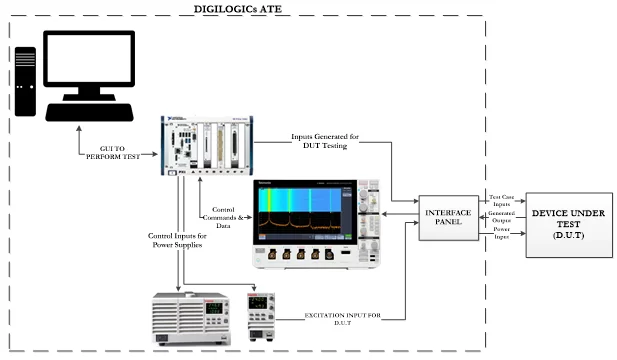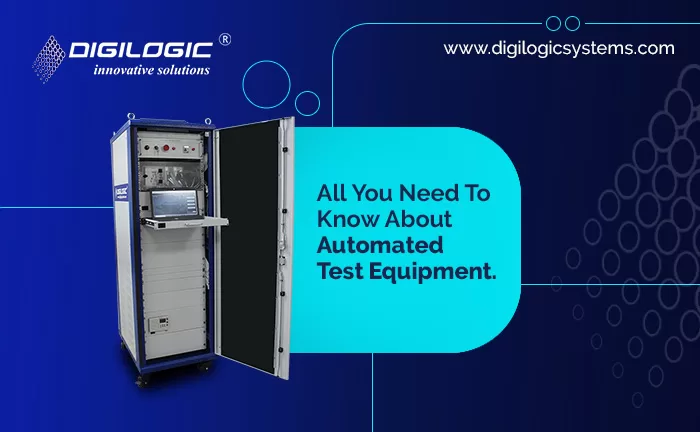The world of R&D, Testing & Measurement is undergoing a sonic transformation and Automated Testing is playing a key role in its evolution. When businesses choose to invest in Automated Test Equipment (ATE), it is often because they believe this will have a transformative impact on their testing capabilities. ATEs enable designers and manufacturers to optimize their test cycles for precision and reduce the time, cost, and risk associated with testing. In this blog post, we will explore what automated test equipments are and how it can deliver a measurable ROI for manufacturers.
WHAT IS AUTOMATED TEST EQUIPMENT?
Automated Test Equipment’s (ATEs) are integrated systems which automate the process of testing modules, systems, devices or products. Test equipment are generally used to monitor and control the operation of a process or device, verify compliance standards, and detect and mitigate risks.
Test automation involves the use of software programs and operating procedures to document, analyze, and control testing procedures so that tests are performed consistently and in an efficient manner. During testing, an ATE is used to control the operation of the “System Under Test (SUT)”, record and store test data, and consolidate a report on the test’s findings. These systems can be used to test a range of products in various industries.
The most common types of Automated Test Equipment are simulators, evaluation systems, functional/electrical test systems, impedance test systems, board-level testers, and networked automated test systems. In the recent past, Users have procured a lot of ATE equipment from Digilogic and have benefited not only with respect to having foolproof testing but also a quicker testing process, Robust test procedures which result in a reduction in time for Govt to Market time and failures on the field. All of this has helped our clients in reducing R&D in prototyping without compromising on the testing methodology, finally resulting in High profitability.

Figure: Digilogic ATE
HOW DOES AUTOMATED TEST EQUIPMENT BOLSTER YOUR ENGINEERING?
An ATE can eradicate misleading results in test reports, by automating processes that are prone to human error. When testing is automated, test results are consistent and cannot be misinterpreted. This can also help to ensure consistency in the quality of products.
Additionally, ATEs can help reduce the cost of testing by reducing the time-to-test and materials needed. This is achieved by using programmable features on ATEs to automate testing sequences. Users have used one Digilogic Automated test Equipment for various applications ranging from Underwater Unit Under Test (UUT) to Ground-based high-performance UUT all the way to space-born UUT.
Every client who needs an ATE always has a unique problem at hand. Hence, we at Digilogic need to come up with unique testing procedures keeping in mind the client’s requirements. Unlike product bases systems, we have to tailor-make every ATE keeping in mind our client and his requirements.
Digilogic Automated Test Equipment are designed in a modular fashion, enabling the user the flexibility of upgrading the system at any point in time. The users are found to use one ATE for multiple variants of the UUT just by plugging in additional resources to the existing setup.
KEY AUTOMATION TOOLS YOU’LL FIND IN ATE EQUIPMENT
Computer-Controlled Systems: These systems provide an interface to oversee the control of each module in an integrated testing system while facilitating the exchange of information between its modules and offering up compiled test reports after calculating the measurements from each of the modules. The most common types of computer-controlled systems are the digital mustimeter (DMU), the digital oscilloscope, the computer terminal, waveform generators and DC power supplies.
Data Storage/Retrieval: Data storage/retrieval systems are used to record test data into a computer-type storage device for later analysis.
Test Program Software: Test program control (or test program design automation) systems are used to control the operation of the test equipment by executing pre-programmed instructions. They are usually designed to control complex ATEs and consist of a computer and associated data input/output devices.
Signal Source: A signal source is used to provide the input voltage, current, or frequency required to test a specific system under test.
Interface Panel: Test probes/connectors are used to interface the test equipment with a specific system under test.
Indicators: Indicators are used to observe the operation of the system under test manually.

Figure: Block Diagram of an ATE from Digilogic Systems
DEFINE YOUR TESTING REQUIREMENTS BEFORE SELECTING EQUIPMENT
The most important aspect of implementing an ATE effectively is to understand the specific testing requirements of each product. This will help you select the right equipment and design the appropriate test fixtures. Make sure you understand the steps in testing, the required test coverage, and the types of failures that must be detected. Once you have this information, you can identify the type of automated test equipment that will best support your testing requirements, including the number and placement of fixtures on the equipment.
INTRODUCE BREAKPOINTS AND THRESHOLDS TO TRIGGER ADDITIONAL TESTS
An advantage of Automated Test Equipment (ATEs) is the feasibility of programming them to suit your unique testing conditions. One example would be if the System under test is undergoing a specific test cycle, the user shall depute one Engineer to help oversee any anomalous conditions that may arise during testing such as Open/Short circuit conditions.
Here the Engineer would have to wait and oversee the entire test procedure, making sure to document the conditions thoroughly. In an ATE, the Test Program Software can be designed to automatically log data with specific time stamps if any thresholds are crossed or any anomalous readings are detected. When the test cycle is completed, the User is able to verify the test report in its entirety and come up with actionable insights.
KEY TAKEAWAYS
Today’s manufacturing environment is more complex than ever. To meet these challenges, manufacturers are exploring ways to streamline their processes and drive efficiency. By utilizing automated test equipment strategically in your manufacturing process, you can see an improvement in production output with better financial returns. Matching the right software and modular hardware is imperative to building successful test systems.
At Digilogic Systems, we have been in the business to address the most challenging automation requirements and provide our users with the best testing platform which helps them to reduce the time to market drastically. Our users get the unique advantage to get a custom testing platform tailor-made to their testing needs, this helps them to cut down costs on unwanted tests which might not be relevant to their platform. Hence enhancing the use of the ATE design developed by us.

